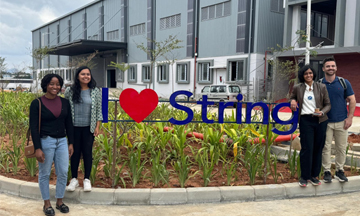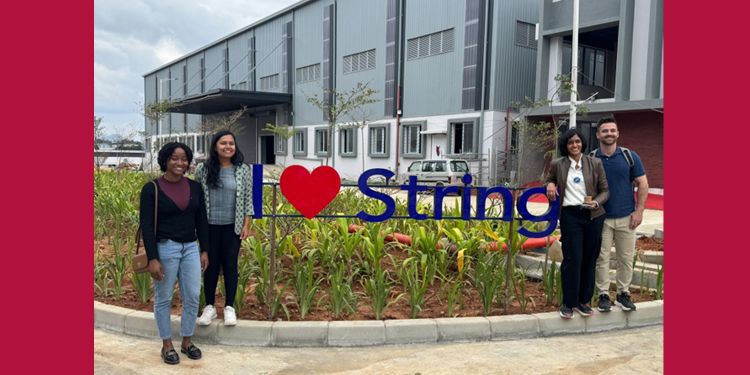Professor Vikram Gandhi’s Immersive Field Course (IFC) “Development while Decarbonizing: India’s Path to Net-Zero" delved into the critical aspect of decarbonization and sustainability goals amid India's rapid development. The course presented an opportunity for students to advance their knowledge of sustainability efforts, decarbonization, and net zero in the context of a broader development agenda. The class culminated in a series of site visits in January 2025 in Mumbai and Bangalore and this is one of 9 student essays that highlights their reflections on uncovering sustainable solutions across the country.
Rice cultivation is at the heart of India’s agricultural landscape, feeding over 60% of the population and supporting the livelihoods of millions. As the world’s second-largest rice producer, India contributes nearly 20% of global rice output. However, this cornerstone of food security comes with a heavy environmental cost—responsible for approximately 35% of India’s total methane emissions. Addressing the environmental impact of rice farming while safeguarding farmer livelihoods is a monumental challenge. Through our research and site visits, we explored innovative strategies to decarbonize rice farming, focusing on sustainable practices, viable crop alternatives, and the critical role of policy and financial support.

The Emissions Challenge in Rice Farming
Flooded paddy fields, essential for traditional rice cultivation, create anaerobic conditions that promote methane-producing bacteria. This, combined with improper residue management practices and overuse of fertilizers exacerbates greenhouse gas emissions.
India’s rice farming sector is also highly vulnerable to climate change. Rising temperatures, water scarcity, and extreme weather events threaten yields, with studies showing that a 1°C increase in nighttime temperature could reduce rice yields by up to 10%.
Indian farmers are also not able to charge a premium for sustainable products, limiting their interest to switch.
Innovative Practices to Mitigate Emissions
Our research identified several practices to reduce emissions while maintaining agricultural productivity and commercial viability:
1. Alternate Wetting and Drying (AWD): This method intermittently drains fields instead of continuous flooding, reducing methane emissions and conserving water.
2. Direct Seeding of Rice (DSR): A method of growing rice by planting seeds directly into the field instead of transplanting seedlings from a nursery.
3. Precision Nutrient Management: Optimizing fertilizer application minimizes nitrous oxide emissions and improves soil health.
4. Rice Straw Management: Alternatives like incorporating straw into soil or using it for bioenergy production prevent emissions from straw burning.
5. Climate-Resilient Rice Varieties: Developing rice strains that require less water and produce lower methane emissions offers a long-term solution to climate risks.
Exploring Alternatives to Rice
Transitioning from water-intensive paddy farming to alternative crops presents an opportunity to balance food production with ecological sustainability. Viable alternatives include:
● Millets: Drought-resistant grains that require minimal water and fertilizers while enriching soil health.
● Legumes and Pulses: These nitrogen-fixing crops reduce the need for synthetic fertilizers, conserve water, and offer diverse income streams for farmers.
● Jute: With its negligible carbon footprint and demand for eco-friendly products, jute offers economic and environmental benefits.
For these alternatives to succeed, robust market systems, infrastructure investments, and consumer awareness campaigns are essential.
Takeaways from Our Site Visits
Our visit with StringBio, Varaha, and Mitti provided firsthand insights into the innovative ways Indian companies are addressing agricultural sustainability challenges.
StringBio: Revolutionizing Farming with CleanRise
StringBio’s CleanRise solution is a game-changer in rice farming. Using gaseous feedstock, CleanRise enhances rice productivity by 15–20% while improving grain quality and reducing methane emissions by 50%. Farmers also benefit financially, earning 1–2 carbon credits per acre of cultivation. With the potential to generate 11–15 million carbon credits annually, StringBio is driving both economic and environmental benefits.
The company’s emphasis on affordability and commercial viability ensures accessibility for smallholder farmers and balancing unit economics with environmental goals is central to their success.
During our visit to StringBio, we had the privilege of touring their factory, which, though still partially under construction, was deeply impressive. The founders spoke about many challenges in its construction but mentioned that the support and zeal from the government to promote sustainability has been tremendous.
Varaha: Advancing Carbon Neutrality
Varaha is a climate-tech startup helping farmers adopt regenerative agriculture practices to reduce greenhouse gas emissions and generate carbon credits. Key techniques include:
● Direct Seeding of Rice (DSR): Planting rice seeds directly into soil without tilling.
● Crop Residue Management: Enhancing soil health while cutting emissions from burning.
● Crop Rotation and Cover Crops: Boosting soil fertility and resilience through sustainable planting cycles.
Using remote sensing and machine learning, Varaha validates farmers’ practices, quantifies emissions reductions, and sells the resulting carbon credits. These credits provide farmers with additional income while supporting companies’ carbon neutrality goals.
Though India’s carbon market is currently voluntary, Varaha is preparing for the transition to a regulated system by ensuring that credits meet strict standards, including proof of permanence. Varaha’s work not only reduces emissions but also improves soil health, increases yields, and enhances climate resilience, demonstrating how carbon markets can create shared value for businesses, farmers, and the environment.
MittiLabs: Empowering Farmers through Climate Action
Mitti’s mission centers on aligning farmer welfare with climate goals. By diversifying its revenue streams beyond carbon credits, Mitti aims to create lasting impacts on farmers’ quality of life. The leadership stressed the importance of co-benefits, such as reducing methane emissions while enhancing farmer income, as key drivers of their strategy.
During our visit, Mitti also underscored the need for robust verification systems to ensure environmental impact while building trust with farmers and investors. Their approach highlights how sustainability efforts can be both inclusive and impactful.
Key Themes Across Companies
1. Farmer-Centric Solutions: Each company emphasized practical, scalable innovations that directly benefit farmers.
2. Integration with Carbon Markets: Leveraging carbon markets to incentivize sustainable practices is a shared priority, though equitable benefit-sharing remains a challenge.
3. Balancing Profitability and Impact: From StringBio’s scalable economics to Mitti’s revenue diversification, these companies demonstrated that sustainability and economic success can be complimentary.
The Role of Policy and Financial Support
Policy reform is essential to scaling sustainable practices. India’s methane reduction targets should align with its Paris Agreement commitments, providing a framework for the agricultural sector to decarbonize. Integrating rice farming into carbon credit programs could incentivize farmers to adopt low-emission practices while generating additional income.
Financial mechanisms such as subsidies for AWD equipment, biofertilizers, and residue management tools can further reduce barriers to adoption. Collaborative financing models, blending public and private investments, offer a promising pathway to scale innovations sustainably.
Conclusion
India’s journey toward decarbonizing rice farming is both a challenge and an opportunity. The solutions we observed—from CleanRise’s transformative technology to Mitti’s focus on farmer empowerment—demonstrate the potential for innovation to drive meaningful change.
Achieving sustainability in rice farming requires a multi-pronged approach: adopting adaptive practices, promoting crop diversification, integrating with carbon markets, reaching commercial viability and enacting supportive policies. With the right mix of innovation, collaboration, and commitment, India can lead the way in creating a sustainable agricultural future that benefits both farmers and the planet.

